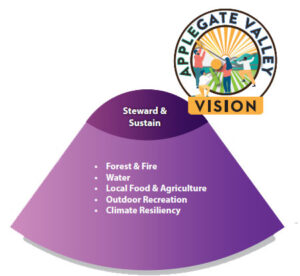 A coloring book that doubles as whimsical field guide to our beloved Cantrall Buckley Park.
A coloring book that doubles as whimsical field guide to our beloved Cantrall Buckley Park.
 Salamanders the size of children. A friendly-faced cougar hanging out near a campfire. A Great Blue Heron relaxing near a playground. A cat on a leash. These are just some of the images that fill the Cantrall Buckley Park Environmental Coloring Book. The recently-released coloring book was partially funded by an Innovation grant from A Greater Applegate and alphabetically documents the treasures of our park.
Salamanders the size of children. A friendly-faced cougar hanging out near a campfire. A Great Blue Heron relaxing near a playground. A cat on a leash. These are just some of the images that fill the Cantrall Buckley Park Environmental Coloring Book. The recently-released coloring book was partially funded by an Innovation grant from A Greater Applegate and alphabetically documents the treasures of our park.
It runs from the Art of Cheryl Garcia, to Skunks, to “Zoomed-in” depictions of dragonflies and pussy ears flowers.
At dozens of listening sessions hosted by A Greater Applegate throughout the Valley, residents expressed the desire for projects that “steward and sustain” our local environment. The coloring book aligns strongly with this goal and speaks to some of the other goals outlined in the Applegate Valley Vision, such as making the valley “Prosperous and Vital,” “Inclusive and Engaged,” “Vibrant and Livable.”
The point person for the project was Thalia Truesdell, a resident of the Applegate Valley for 35 years. The former library branch manager worked with Ruch Outdoor Community School to write the Innovation grant proposal and then organize and produce the dozens of drawings that fill the book. Truesdall had originally envisioned a scientific guide to the park’s flora and fauna, but let that idea go.
“Because of the alphabetical format of the book, and the often-whimsical nature of young children’s drawings, our emphasis on scientific precision began to wane,” she writes in the book’s introduction. That’s why you’ll see vultures perched next to volleyball games.
 It’s just as well. Her main goal was achieved: Helping the children become more observant of Cantrall Buckley’s abundance. After spending time in the park and consulting bird and flower guides, Truesdall says they gained a new appreciation for the park. “They were like: ‘Wow, we have Martens, Fishers, and Long-tailed Weasels?!’”
It’s just as well. Her main goal was achieved: Helping the children become more observant of Cantrall Buckley’s abundance. After spending time in the park and consulting bird and flower guides, Truesdall says they gained a new appreciation for the park. “They were like: ‘Wow, we have Martens, Fishers, and Long-tailed Weasels?!’”
For those with a scientific bent, the back of the book features photographs of the animals and plants featured in the book, suitable for use as a field guide for the Park.
The group went through all the ups and downs and joys and challenges that come with any creative project. Some of the kids had actually never drawn before. “It was really fun,” she says. “The students’ growth was astonishing.” Indeed, the drawings will have any adult longing to recapture the unselfconscious artistic freedom that we so often lose along the way.
Truesdell gives the students full credit for the project from start to finish: “It was definitely US working together.”

